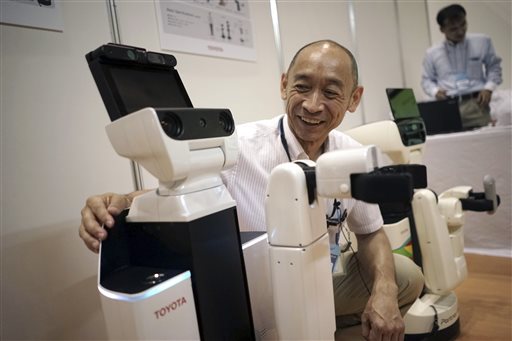Toyota robot can pick up after people, help the sick

Toyota’s engineer Kouichi Ikeda looks at new HSR, left, short for “human support robot,” at a welfare and nursing exposition in Yokohama, south of Tokyo on July 24, 2015. AP
YOKOHAMA, Japan—Toyota’s new robot that glides around like R2-D2 is devoted to a single task: picking things up.
HSR, short for “human support robot,” comes with a single mechanical arm that can grasp objects of various shapes and sizes and also pick up smaller items with a tiny suction cup.
It doesn’t have other tricks in its repertoire, except for a computer panel on its head for surfing the Internet. A person can also access the robot from another computer and use it like a camera-phone.
Kouichi Ikeda, its engineer, is serious about using it to help around regular homes. First people with disabilities, and then for the elderly in general. Picking up is especially challenging for people with spinal disorders and other ailments that hamper the ability to stoop down and grab, he said.
“Although it can only do one simple task of picking up, it’s already making disabled people quite happy. We’re just getting stated, but eventually we want it to enter people’s homes,” Ikeda said at an exhibition of health care technology in Yokohama, southwest of Tokyo.
Nearly 40 percent of Japan’s population will be 65 or older by 2060, and with the rest of the developed world and some developing nations following that track, Toyota is banking on the demand for robot helpers to grow.
“People feel more comfortable asking a robot to pick up after them than asking a human helper,” said Tadashi Hatakenaka, manager and engineer at the Yokohama Rehabilitation Center.
A robot like HSR is also ideal to replace service dogs, which go through special training to help people with various disabilities, including those who use wheelchairs, have balance issues or may be prone to seizures, he said.
Toyota came up with the basic concept model for HSR in 2012.
The revamped model, announced this month, is ready to enter universities, research facilities and businesses from next year, in partnerships to develop more applications, so the robot can enter homes as quickly as possible.
One drawback is cost. Mass production is needed for the price to come down. Toyota declined to give the current price.
Ikeda showed how HSR can be controlled relatively easily by tapping on a tablet device, to fetch a TV remote-controller.
The 135 centimeter (four-foot-four) tall robot has several cameras, including two on its head that look like its eyes, and sensors on its body. It scoots quietly around in all directions.
Unlike the robotic arms at auto-assembly plants, HSR’s grip and bumps are designed to be soft so they can’t hurt anyone. But it can pick up items weigh up to 1.2 kilograms (2.6 pounds).
There was no attempt to make its design cute, like the Pepper childlike robot that recently went on sale in Japan from Japanese Internet company Softbank Corp.
Toyota has long been working on robots, including a human-shaped one with fingers dexterous enough to play the trumpet. Another plays the violin.